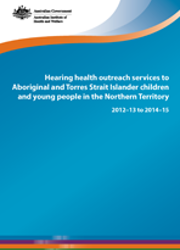Hearing health outreach services to Aboriginal and Torres Strait Islander children and young people in the Northern Territory: 2012–13 to 2014–15
Citation
AIHW
Australian Institute of Health and Welfare (2015) Hearing health outreach services to Aboriginal and Torres Strait Islander children and young people in the Northern Territory: 2012–13 to 2014–15, AIHW, Australian Government, accessed 20 April 2024.
APA
Australian Institute of Health and Welfare. (2015). Hearing health outreach services to Aboriginal and Torres Strait Islander children and young people in the Northern Territory: 2012–13 to 2014–15. Canberra: AIHW.
MLA
Australian Institute of Health and Welfare. Hearing health outreach services to Aboriginal and Torres Strait Islander children and young people in the Northern Territory: 2012–13 to 2014–15. AIHW, 2015.
Vancouver
Australian Institute of Health and Welfare. Hearing health outreach services to Aboriginal and Torres Strait Islander children and young people in the Northern Territory: 2012–13 to 2014–15. Canberra: AIHW; 2015.
Harvard
Australian Institute of Health and Welfare 2015, Hearing health outreach services to Aboriginal and Torres Strait Islander children and young people in the Northern Territory: 2012–13 to 2014–15, AIHW, Canberra.
PDF | 6.7Mb
This is the third annual report on hearing health outreach services provided to Aboriginal and Torres Strait Islander children and young people in the Northern Territory, funded by the Australian Government. It reports on outreach audiology, ENT teleotology, and Child Hearing Health Coordinator services provided from July 2012 to June 2015. There is evidence to suggest the effectiveness of these programs in improving ear and hearing health among service recipients – of almost 1,000 children and young people who received multiple outreach audiology services in 2012–15 and who had hearing loss at their first service, one-third had no hearing loss at their most recent service.
- ISBN: 978-1-74249-846-1
- Cat. no: IHW 163
- Pages: 134
-
46% of audiology service recipients had hearing loss and 29% had a hearing impairment
-
64% were diagnosed with at least 1 type of ear condition
-
The severity of impairment improved for 56% of children, did not change for 37%, and deteriorated for 6%
-
The proportion of children and young people diagnosed with at least 1 ear condition decreased by 27 percentage points



